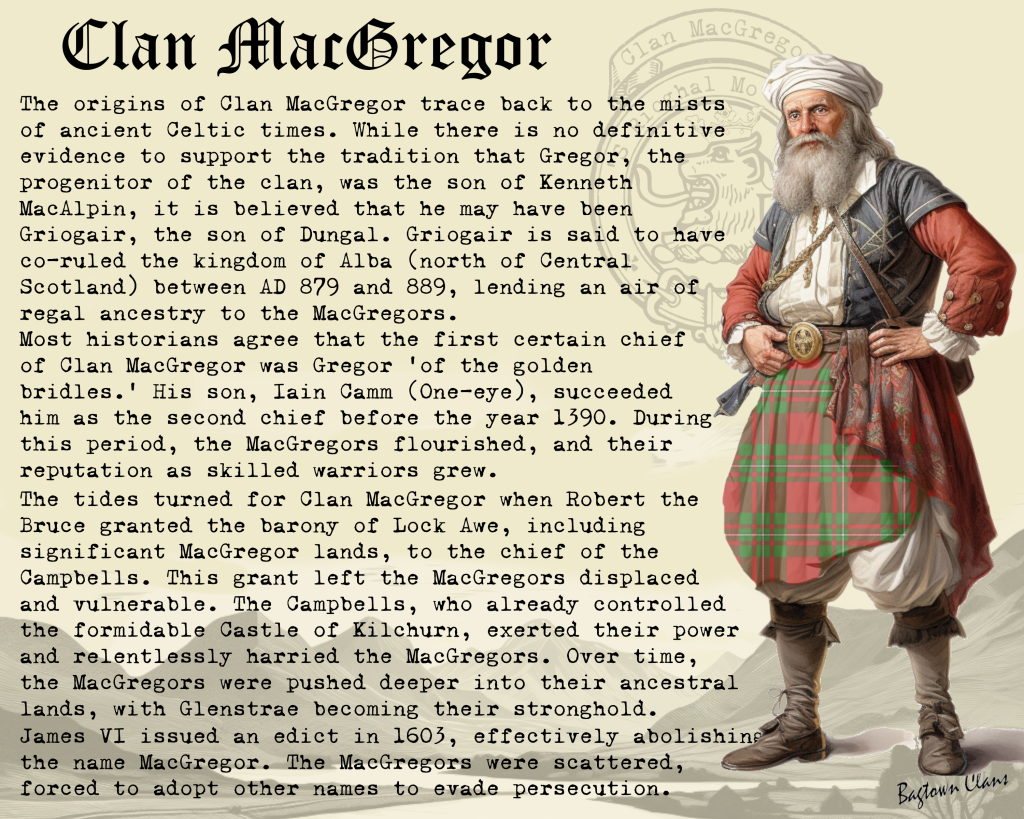Clan MacGregor
|
|
CREST: A lion’s head erased Proper, crowned with an antique crown Or MOTTO: ‘S rioghal mo dhream TRANSLATION: My race is royal VARIATIONS: McGregor, Gregor |
 The origins of Clan MacGregor trace back to the mists of ancient Celtic times. While there is no definitive evidence to support the tradition that Gregor, the progenitor of the clan, was the son of Kenneth MacAlpin, it is believed that he may have been Griogair, the son of Dungal. Griogair is said to have co-ruled the kingdom of Alba (north of Central Scotland) between AD 879 and 889, lending an air of regal ancestry to the MacGregors. The origins of Clan MacGregor trace back to the mists of ancient Celtic times. While there is no definitive evidence to support the tradition that Gregor, the progenitor of the clan, was the son of Kenneth MacAlpin, it is believed that he may have been Griogair, the son of Dungal. Griogair is said to have co-ruled the kingdom of Alba (north of Central Scotland) between AD 879 and 889, lending an air of regal ancestry to the MacGregors.
Most historians agree that the first certain chief of Clan MacGregor was Gregor ‘of the golden bridles.’ His son, Iain Camm (One-eye), succeeded him as the second chief before the year 1390. During this period, the MacGregors flourished, and their reputation as skilled warriors grew.The tides turned for Clan MacGregor when Robert the Bruce granted the barony of Lock Awe, including significant MacGregor lands, to the chief of the Campbells. This grant left the MacGregors displaced and vulnerable. The Campbells, who already controlled the formidable Castle of Kilchurn, exerted their power and relentlessly harried the MacGregors. Over time, the MacGregors were pushed deeper into their ancestral lands, with Glenstrae becoming their stronghold. The 16th and 17th centuries marked a period of immense hardship for Clan MacGregor. Colin Campbell of Glenorchy, who purchased the superiority from his kinsman, the Earl of Argyll, refused to recognize the claim of Gregor Roy MacGregor to the estates. As a result, Gregor Roy waged a decade-long war against the Campbells, ultimately becoming an outlaw and leading a life of raids and sheltering in the rugged glens.In 1570, the Campbells captured and killed Gregor Roy MacGregor. His son, Alistair, sought to claim the chiefship, but the tide of persecution against the MacGregors continued to rise. The infamous incident involving John Drummond, the king’s forester, and the subsequent condemnation of the MacGregor chief by the Privy Council led to James VI issuing an edict in 1603, effectively abolishing the name MacGregor. The MacGregors were scattered, forced to adopt other names to evade persecution. The plight of Clan MacGregor persisted until 1774 when the laws against them were repealed. To restore their clan’s pride, a petition subscribed by eight hundred and twenty-six MacGregors declared General John Murray of Lanrick, a descendant of Duncan MacGregor of Ardchoille, as the true chief. General John Murray, a decorated military officer who had served extensively in India, assumed the mantle and played a vital role during George IV’s visit to Scotland in 1822. |
|
Citations:
|
|

 Purchase @ Redbubble
Purchase @ Redbubble
Purchase @ Amazon.com
Purchase @ Amazon.co.uk
